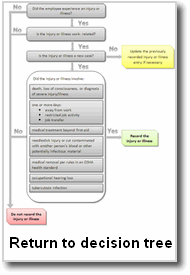Coordinators
Days away from work
When an injury or illness involves one or more days away from work, you must record the injury or illness on the OSHA tab:
- Select R for the OSHA Recordable field
- Enter the appropriate information for the Privacy Case and Injury/Illness fields
- Select code 3 for Days Away From Work in the Severity field
- Enter the number of days away from work in the OSHA Lost Days field
If the employee is out for an extended period of time, you must enter an estimate of the days that the employee will be away, and update the day count when the actual number of days is known.
Counting days
When to begin counting days: You begin counting days away on the day after the injury occurred or the illness began.
Weekends, holidays, or other days the employee would not have worked anyway: You must count the number of calendar days the employee was unable to work as a result of the injury or illness, regardless of whether or not the employee was scheduled to work on those day(s). Weekend days, holidays, vacation days or other days off are included in the total number of days recorded if the employee would not have been able to work on those days because of a work-related injury or illness.
Count limit: You may “cap” the total days away at 180 calendar days. You are not required to keep track of the number of calendar days away from work if the injury or illness resulted in more than 180 calendar days away from work and/or days of job transfer or restriction. In such a case, entering 180 in the total days away field will be considered adequate.
Restricted work or job transfer
When an injury or illness involves restricted work or job transfer but does not involve death or days away from work, you must record the injury or illness on the OSHA Tab:
- Select R for the OSHA Recordable field
- Enter the appropriate information for the Privacy Case and Injury/Illness fields
- Select code 4 for Restricted Work Activity or Job Transfer in the Severity field
- Enter the number of restricted or transferred days in the OSHA Restricted Days field
Definitions
Restricted work — Restricted work occurs when, as the result of a work-related injury or illness:
(A) You keep the employee from performing one or more of the routine functions of his or her job, or from working the full workday that he or she would otherwise have been scheduled to work; or
(B) A physician or other licensed health care professional recommends that the employee not perform one or more of the routine functions of his or her job, or not work the full workday that he or she would otherwise have been scheduled to work.
Examples of restriction or transfer include these cases:
- The employee works only for a partial work shift because of a work-related injury or illness
- The doctor recommends a job restriction, but the employee does all of his or her routine job functions anyway
- An injured or ill employee is assigned to a job other than his or her regular job for part of the day
Routine functions —For recordkeeping purposes, an employee’s routine functions are those work activities the employee regularly performs at least once per week.
Restrictions vs. Routine functions
Is the injury or illness automatically OSHA recordable as a “restricted work” case If a physician or other licensed health care professional recommends a work restriction?
No, a recommended work restriction is OSHA recordable only if it affects one or more of the employee’s routine job functions. To determine whether this is the case, you must evaluate the restriction in light of the routine functions of the injured or ill employee’s job.
If the restriction from you or the physician or other licensed health care professional keeps the employee from performing one or more of his or her routine job functions, or from working the full workday the injured or ill employee would otherwise have worked, the employee’s work has been restricted and you must record the case.
Vague restrictions
How do you handle vague restrictions from a physician or other licensed health care professional, such as that the employee engage only in “light duty” or “take it easy for a week”?
If you are not clear about the physician or other licensed health care professional’s recommendation, you may ask that person whether the employee can do all of his or her routine job functions and work all of his or her normally assigned work shift.
If the answer to both of these questions is “Yes,” then the case does not involve a work restriction and does not have to be recorded as such.
If the answer to one or both of these questions is “No,” the case involves restricted work and must be recorded as a restricted work case.
If you are unable to obtain this additional information from the physician or other licensed health care professional who recommended the restriction, record the injury or illness as a case involving restricted work.
Entering ”job transfers” vs. “restricted work” cases on the OSHA Tab
Both job transfer and restricted work cases are recorded using the same code (4 for Restricted Work Activity or Job Transfer) in the Severity field of the OSHA Tab, and both use the OSHA Restricted Days field to keep count of both restricted work and job transfer days.
Counting days of job transfer or restriction
You count days of job transfer or restriction in the same way you count days away from work.


